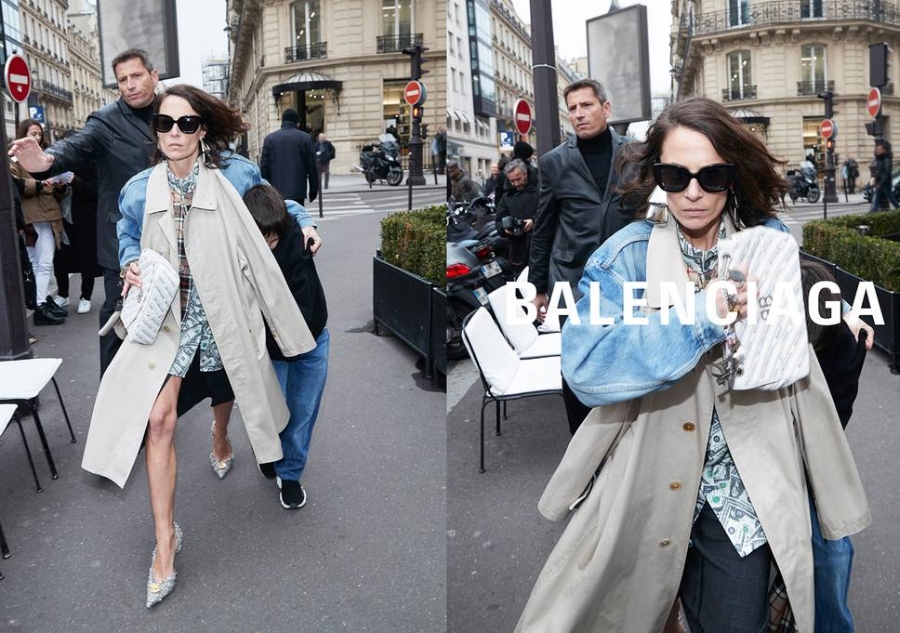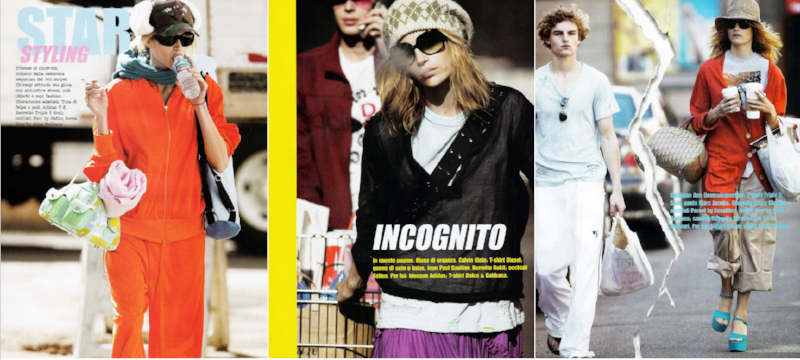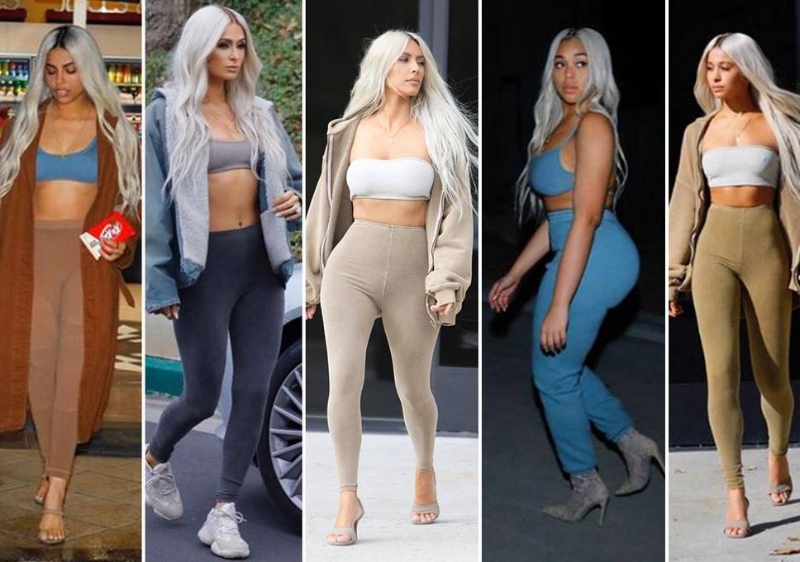
image: Balenciaga
Paparazzi photos have permeated the fashion industry. Whether it be imagery on celebrity news sites of supermodels Kate Moss and Karlie Kloss or editorials and ad campaigns staged in a street peeping manner, society – and the fashion industry – cannot get enough of paparazzi pics. Not unlike how crazed photographers clamored to capture imagery of Jacqueline Kennedy Onassis in the 1970’s (right around the time the so-called “Most Famous Paparazzi Photo Ever” was taken), there is nary an US Weekly in 2018 that is not jam-packed with snaps of the various Kardashian/Jenner family members.
While much has changed quite a bit since Jackie O. adopted her large sunglasses as a means of obscuring the view of paparazzi photographers and imagery of Elizabeth Taylor, Richard Burton, Frank Sinatra, Peter O’Toole, Ava Gardner, David Niven, Shirley MacLaine and Audrey Hepburn graced the pages of magazines, such as LIFE, the allure of off-duty celebrities remains in full force.
The same desire to “see behind the glitz and glamor of a celebrity’s image” in the days of Princess Diana and before that, Marilyn Monroe, is what “drives audiences with equal fervor to [modern] outlets like TMZ,” according to Andrew L. Mendelson, the chair of Temple University’s Department of Journalism.
Taking on the topic of paparazzi photos several years ago, Mendelson wrote that such imagery is particularly noteworthy as it tends to stand in “stark contrast to the glamorous and controlled photographs distributed by the movie studios or the staged images in popular magazines.” These oft-unplanned photos are, as a whole, more realistic that the heavily-manufactured images and personas that these famed figures (with the help of their teams of management, agents, publicists, studio heads, etc.) tend to portray to the world in editorialized imagery, interview sound-bites, and on the red carpet. In 2018, “authenticity,” a full-blown buzz word, is in demand.
“The paparazzi are distinct from photographers who work in situations — posed photo shoots for magazines, red carpets and parties — that allow celebrities control over how they appear,” according to photography scholar Carol Squires. “The paparazzi’s quest for raw, candid photos places them ‘outside the bounds of polite photography.’” And this is exactly what draws us in: What Mendelson describes as the “anti-aesthetic to paparazzi photographs that rejects the ‘official,’ glamorous views of the rich and famous.”
“The best paparazzi photographs,” he says, “emphasize fleeting, stolen moments, ideally produced without the subject knowing he or she is being photographed.”
Modern-Day Paparazzi Complex
Princess Diana’s death in August 1997 is telling of the modern state of paparazzi fury. As TIME wrote last year, “The speeding car carrying Diana away from the paparazzi crashed into a pillar, killing her and her then fiancée Dodi al-Fayed. At her funeral in September 1997, her brother Charles Spencer left mourners in no doubt who he blamed, describing his sister as ‘the most hunted person of the modern age.’”
But despite such tragedy, the collective fascination with celebrity has not dimmed; if anything, it seems to have only increased significantly since our lives started being played out online, where paparazzi images are shared virally across social media and entire websites are dedicated to off-duty celebrity imagery, giving us unfettered access to our fav celebs.
Why are we so obsessed? Author Julie Klam put forth some suggestions in her book, The Stars In Our Eyes, one of which, is that it is a pretty harmless (and free) guilty pleasure and form of escape from the realities our daily lives (which for most people are a whole lot less glamorous than those of Hollywood A-listers. “Celebrity worship is one of the only guilty pleasures that doesn’t really hurt anyone. You don’t get fat from it, you don’t get cancer from it, it doesn’t cost anything, and it doesn’t send you into rehab,” per Klam.

images: Vogue Italia
Moreover, celebrities, especially the ones we choose to like, says Klam, represent “the us we want to be.” The practice of scouring the internet for imagery and articles about them, or our practice of following our favorite celebs – or fan accounts – on social media further bolsters this entertainment/escapism theory, as does our willingness, in some cases, to adapt our looks (clothing wise, makeup wise, etc.) to mirror aspects of our favorite famous figures.
With this in mind, it is only natural that fashion – and its penchant for reflecting upon and ideally, capitalizing on, the cultural climate – has taken to using the established appeal of paparazzi-style photos to sell stuff – from Yeezy bike shorts to very Chanel-Looking bags from Balenciaga.
We have seen this in a number of instances over the years. You may recall the 2005 Jimmy Choo ad starring Nicole Richie, who was at the height of her Hollywood “it” girl reign. Thereafter, Guess by Marciano featured a starlet swamped by photographers for its Fall/Winter 2010 ad. This was followed by the Mario Sorrenti-lensed Christian Dior “Miss Dior” bag campaign in 2012, which starred actress Mila Kunis, and Diane von Furstenberg’s Fall/Winter 2014 campaign. For Spring/Summer 2017 Michael Kors’ ad seemed to suggest that bodyguards were attempting to put off prying photographers’ lenses. That same season, Moschino surrounded Insta-models Gigi and Bella Hadid with a handful of eager photogs.
One of the more striking instances came in an editorial capacity, though, by way of Steven Meisel for Vogue Italia. In that spread, Meisel shot Frankie Rayder, Amber Valletta, Liya Kebede, and others in Los Angeles in what appeared to be completely unfixed paparazzi shots, a quintessential ode to all things LA celebrity, right down to a Mary-Kate Olsen-styled Rayder in one frame.
This brings us to the very recent releases of Kanye West’s Yeezy Season 6 campaigns starring Kim Kardashian (easily one of the most paparazzi-photographed women in the world) and then a slew of Kim K clones in the campaign’s “Part II” roll out this week, and Balenciaga’s Spring/Summer 2018 ad campaign, both of which take cues from paparazzi-lensed imagery.
Given the completely digitally-connected world that we inhabit and the ever-present allure of celebrity imagery and our constant quest for “authenticity” which paparazzi photos – as distinct from traditional fashion photos – provide (which is obfuscated here, obviously given the at lest somewhat staged nature of such “paparazzi photos”), the campaigns make a lot of sense.

image: Yeezy
Cultural commentary-wise, the Yeezy and Balenciaga campaigns are spot-on. Paparazzi themes typically have been used by brands, including Dior, Moschino, and Michael Kors, to add an element of glamour/aspirationality to their campaigns. If you wear these clothes and/or carry the bag, you will embody the lifestyle that attracts paparazzi photographers – or so goes the underlying marketing schtick.
That is not necessarily what is at play (or what is the only thing at play) for West and Balenciaga. They are inherently cooler, more culturally aware than that, no? They are not merely looking to elevate the glam or aspiration-factor of their brands (hell, Kim Kardashian is at a gas station in one of the photos; getting out of her car (albeit a Maybach) in another; this is mundane campaign setting at its best).
So, it seems they are more likely playing into our collective consciousness of celebrity culture; tapping into the zeitgeist, including our willingness to clone ourselves to look exactly like our favorite celebrities; and in much the same vein, commenting on the overwhelming marketing power of the celebrity lifestyle, all while keeping the ball firmly within their own courts and attempting to sell stuff, of course.
Mr. West, after all, knows that his best models are himself and his uber-famous wife, without whose influence (and wildly dedicated followings willing to recreate their wardrobes to look like Kim and Ye), he might not have a highly buzzed-about brand, after all. So, why not continue to use that and poke fun at this fact with his latest ad campaign offerings?
And it is here that these campaigns are also pretty darn perfect. They are exactly the type of thing that drive buzz in 2018; fashion industry publications are already saying despite the presence of lackluster (read: blah) garments, the #YeezySeason6 releases have “broken the internet” due to the massive amount of buzz that has surrounded them.
And in our hugely digitally-connected world, that is a significant part of the puzzle, maybe (i.e., definitely) even more so that the clothes, themselves.







